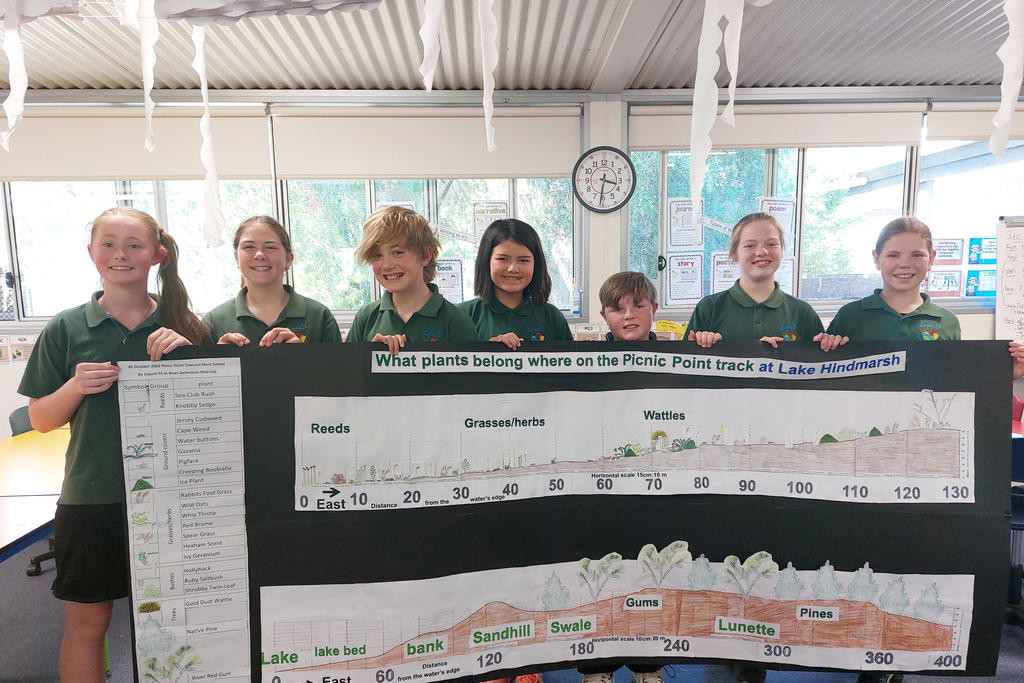General News
3 November, 2025
Jeparit Waterwatch: 30 years water quality monitoring.
Jeparit Waterwatch (JWW) began with a group of retired farmers based at the Museum (bottom photo left) in Jeparit in May 1995.

In that time, JWW has gathered a valuable citizen science record of some 350 recordings for each of six sites on the Wimmera River at Jeparit.
JWW’s other sites, monitored for different periods of time, have reached from Antwerp along the River, to Lake Hindmarsh, plus farm dams, until the advent of pipeline water, and more recently water from the Yarriambiack Creek and its Hopetoun Lakes.
This data covers many changes, with three to six water quality aspects for each recording, of which the most important has been the salinity.
The data can be found on the Waterwatch Victoria website at www.vic.waterwatch.org.au
Basically the story of the River’s salinity in this time divides into four periods.
The Museum site, where the River water arrives in Jeparit, shows this in its graph (see left).
The first period was in the mid-late 1990s, when the River still ran with seasonal patterns, based on fresh fallen winter and spring run-off coming quickly from the upper catchment tributaries.
Many of the Pyrenees tributaries had dams put on them in the late 1990s, just as the Millennium Drought started.
The second period was the Millennium Drought, when regular flows didn’t reach the lower catchment and the salinities soared to sea levels.
The third period was short, when the heavy rainfall returned in spring 2009 and then the Jan 2011 flood.
The fourth period has been for the last 15 years, when the River’s seasonal pattern has returned and, with the aid of environmental flows when needed, the water quality has not reached saline levels most of the time.
Focussing on the last decade at this site ( graph left), salinity had settled down to a fairly regular seasonal pattern, similar to that of the 1990s, until April this year, when the impact of drought and reduced flows has again raised levels to saline water quality, now up to 9000 us/cm ECs.
By regularly going to the same sites, JWW has also observed and recorded seasonal changes with living things (especially plants and birds),and reported concerns and been involved in some actions about these, e.g. Prickly Pear growing along the River; Ash Trees invading the wetlands.
From the start, Jeparit Primary School has been a part of JWW.
Students have conducted many different investigations, including surveys of the River’s ‘water bug’ life, and community actions, including planting groundcovers to protect the soil at the back of the Showgrounds and the 2023 plant research at Picnic Point and its visual report.
Some JWW members have been able to share their monitoring with family.
Monitoring by the Pitt family has stretched over four generations from long-term monitor Frank Pitt, to his daughter Sue Afford, who is carrying on his legacy of collecting from these sites and testing waters, for the last four years, sometimes bringing one of Frank’s great grandsons, Wyatt and Jye Littlejohns, to follow in his footsteps collecting and testing the water.
“I remember that Dad became involved in JWW in 2002, when his sheep refused to drink the River’s water which he pumped into his farm dams," recalled Sue.
"At JWW, he found that the salinity had reached over 30,000ECs - too salty for sheep to drink.
"It would go much higher. It was so exciting when we followed the water flowing back along the River, over the Weir and into the Lake as Drought ended in 2009. It prompted lots of stories about the River from my father."
“In late 2022, we observed an abundance of bird life migrating to the Lake and breed for two seasons: pelicans, black swans, white ibis, and so many different wading birds.
"An estimated 3-5,000 pelicans returned to the Lake, bred on two islands, between the River mouth and Four-mile Beach.
"I loved watching these majestic birds rise into the sky, circling on thermals and swooping over the water, and their green-feathered fledglings wobbling about, learning to feed and eventually master flying.
"As the water reduced we watched the pelicans skilfully school fish into collection areas, then dive into these, coming up with beaks full of fish, which they carried back to their young.
"Such life at the Lake was something I had also enjoyed as a young person in the 1960s and, as the Lake has dried again now, know we won’t see again until there are flows to bring back birds, fish, plants – all the forms of life for the Lake that were there from the 1920s-80s.
“Foundation JWW member David Livingston invited me to collect water samples when he began having difficulties doing so.
"I agreed and we went out in his 4WD vehicle so I could learn the locations from Museum to the Boat Ramp.
"After he passed away, I continued collecting and recording as part of JWW – and have done that for 12 years now,” recalled Martin Stone.
“I’ve seen the River and Lakes through every event for the last 30 years.
"What amazes me most was on the rare occasions when there was very heavy rain over a couple of days, that water can flow straight off from the upper catchment to the lower catchment, arriving at Jeparit as low salinity rainwater as it must have under natural River conditions," said Jeanie Clark.
As JWW heads into its fourth decade of caring for the Wimmera River at Jeparit by keeping tabs on its water quality, the group needs more members to help carry it forward.
If you might be interested, please contact Jeanie at enviroed4all@skymesh.com.au.




